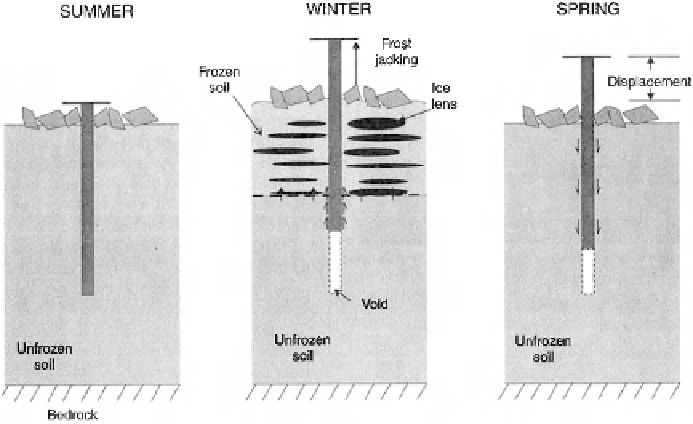Geology Reference
In-Depth Information
14.2. COLD-REGIONS ENGINEERING
A number of geotechnical and engineering problems result from the occurrence of
permafrost. For the most part they relate to the water and/or ice content of permafrost.
These can be summarized as being either frost heave, thaw-subsidence, or hydrologic in
nature.
14.2.1. General Principles
As explained in Chapter 4, pure water freezes at 0 °C and in doing so expands by approxi-
mately 9% of its volume. The most obvious result of soil freezing is the volume increase
(heave) that results and the associated deformation of host sediment and rock. The heave
has considerable practical signifi cance since it causes displacement of buildings, founda-
tions, and road surfaces. For soil to heave, the ice must fi rst overcome the resistance to
its expansion caused by the strength of overlying frozen soil. This usually occurs only when
segregated ice lenses form. Frost heave causes signifi cance damage to structures and
foundations. In the case of pile foundations, repeated cycles of heave can progressively
lift piles (Figure 14.1), in the same manner that frost-jacking of bedrock occurs (see
Chapter 6). The annual cost of rectifying seasonal-frost damage in roads, utility founda-
tions, and buildings in areas of permafrost and deep seasonal-frost, as present in areas of
Canada, Alaska, Sweden, and northern Japan, is considerable. The costs of maintaining
and upgrading some of the ageing and more primitive infrastructures in areas of northern
Russia and northern China are even greater.
As explained in Chapter 7, ground ice is a major component of permafrost, particularly
in fi ne-grained and unconsolidated sediments. Numerous case studies now document the
ground subsidence that follows the thaw of ice-rich permafrost (see above). Thaw consoli-
dation may occur as thawed sediments compact and settle under their own weight; the
Figure 14.1.
Seasonal frost jacking of piles. Freezing in winter causes pile foundations to lift. In
spring and summer, piles do not return to their original position. From Wolfe (1998).

